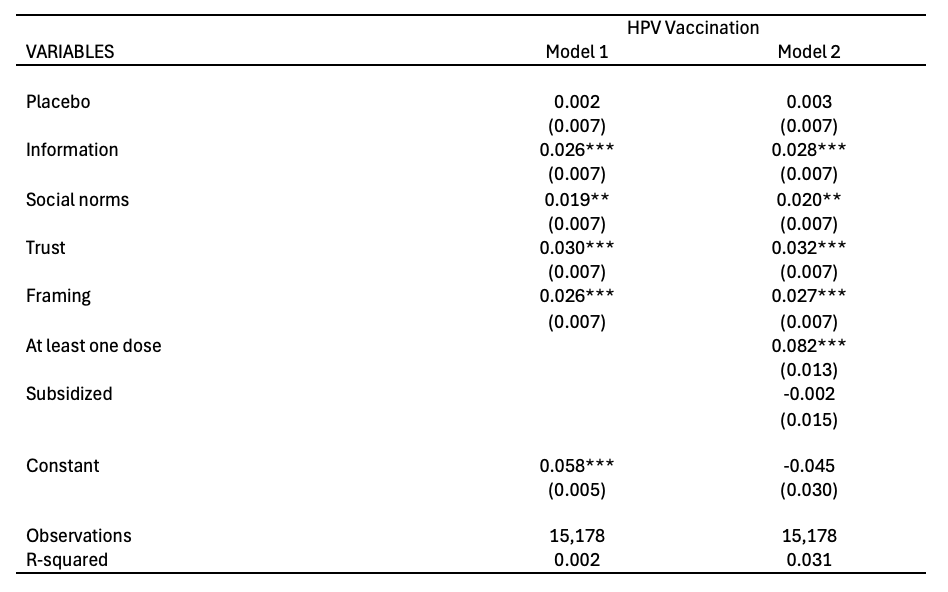Combating vaccine hesitancy using Behavioral Economics insights: The case of HPV vaccination in Cali

Context
Cervical cancer is a major cause of female mortality in Latin America and the Caribbean (LAC), accounting for 80% of all cervical cancer deaths in the Americas (PAHO, 2022). In Colombia, cervical cancer is the third most frequent cancer among women and the second leading cause of cancer-related deaths in women aged 15 to 44 years (HPV Information Center, 2023).
Unlike many other cancers, cervical cancer is primarily caused by a virus: the Human Papilloma Virus (HPV), which can be transmitted through oral, vaginal, or anal sexual contact. Fortunately, the risk of HPV infection and developing cervical cancer can be prevented through a vaccine which is administered free of charge to girls and adolescents between the ages of 9 and 17 in Colombia.
Despite wide availability and access to the HPV vaccine, vaccination rates for first dose by age 15 decreased from over 75% in 2019 to lower than 45% in 2022, according to the World Health Organization (WHO). In Cali, the situation is even more alarming, as vaccination rates for the first dose have plummeted from over 74% in 2019 to a mere 17% in 2020. (N Munoz et al, 2020: HPV world). Hence, it is crucial for the Health Secretariat in Cali to improve communication strategies with its citizens on the topic of HPV vaccination.
Project
The purpose of this project is to increase vaccination rates against HPV by employing behavioral economics principles when sending text messages to the targeted population. Our objective is to strengthen the communication strategies used by the Secretariat of Health in Cali by evaluating the effectiveness of different types of content within the text messages sent. This project was designed to enhance the existing strategies implemented by the Secretariat of Health in Cali. The target population included 15,231 parents affiliated with EPS SURA (a health insurance company in Cali) whose daughters were between 9 and 17 years old.
Availability heuristic: Individuals judge the probability of a future event occurring based on the ease with which an occurrence of such an event comes to mind. Parents may find it easy to remember a highly publicized event (Carmen de Bolívar incident) where girls had adverse effects to the HPV vaccine and use this ease of recall as a judgement of the risks of the vaccine despite most facts pointing to the vaccine's safety.
Social Norms: The unwritten rules governing behavior within a society. A distinction is drawn between “descriptive norms,” which describe the way in which individuals tend to behave, and “prescriptive norms,” which establish what is considered acceptable or desired behavior, independent of how individuals actually behave. Parents may be more likely to vaccinate their daughters when they believe all other parents do so as well or when they are shown that vaccination against HPV is the most acceptable/moral behavior.
Lack of Information: People may lack relevant information because, for instance, information is difficult to obtain, scarce, or hard to understand. Likewise, people may not know that the HPV vaccine is free or the location of vaccination sites, leading to low vaccination rates against HPV.
Mistrust: A lack of trust occurs when one party is unwilling to rely on the actions of another party in a future situation. If the government or doctors do not explicitly support and outline the vaccine's benefits and the low risks of vaccination, parents may question the legitimacy and security of the vaccine against HPV.
Endowment effect: People place more value on things simply because they possess them. This overvaluation of a good is due to an “aversion to losing it,” among other things. Informing parents that there is an HPV vaccine reserved and waiting for their daughter may trigger loss aversion in relation to the vaccine.
Cognitive overload: When the amount of information exceeds a person’s mental capacity to process it, attention and memory are strained. For example, providing parents with too much complex information about the HPV vaccine and vaccination steps may overwhelm them, making them less likely to vaccinate their daughters.
Behavioral Tools
Provision of Information: A process where information is provided to subjects for decision making. Text messages may provide information such as HPV vaccination sites and reminders that the vaccine is free for girls aged 9-17.
Framing: Given the tendency to draw different conclusions depending on how information is presented, the desired options can be presented so as to emphasize the relevant part of the information, as well as to highlight the positive or negative aspects of a decision, leading an option to be perceived as more or less attractive. For example, informing parents that they must have 21 vaccines in their daughter’s vaccination card and that they specifically need the HPV vaccine in order to complete the card may encourage parents to vaccinate their daughters because they would want to reduce perceptions of incompleteness.
Reminders: These may consist of an email, text messages, a letter, or a personal visit to remind the person making the decision about some aspect of their decision-action. These are aimed at mitigating procrastination, forgetfulness, and cognitive overload for those who must make the decisions. Specifically, in the absence of reminders from the health system, parents may forget to vaccinate their daughters with the second dose of the vaccine against HPV.
Personalization: Personalizing information based on individual characteristics and traits of identity is shown to improve responsiveness and outcomes. This could take the form of approaching someone by using their name, nationality, profession, or other characteristics. SMS sent to parents may use the parent’s name or the daughter's name to make the message more personal and individualized.
Descriptive Norms: These describe how a social group behaves, without regard for whether the behavior is good or bad. Presenting them can help change behavior. For instance, the message sent to parents could present information on the number of people who have already vaccinated their daughter against HPV.
Prescriptive norms: Refers to whether society approves or disapproves of certain behavior—that is, describes it as good or bad. This is regardless of whether society follows this behavior. This is useful for reaffirming or recognizing good individual behavior while discouraging bad behavior. Text messages can highlight the number of parents who have already vaccinated their children as well the fact that their own daughter is still missing their HPV vaccine along with a sad emoji face.
Trending norms: Norms in which an increasing number of people perform specific actions. For instance, text messages can highlight percentage increase in vaccination rates from the previous year to the current year.
Dynamic norms: Norms in which people are more likely to start a new behavior if they perceive many people are also engaging in this new behavior. Informing parents that an increasing number of people are vaccinating their daughters can encourage them to vaccinate their own daughter against HPV.
Salience: Our attention is limited. Therefore, behavioral economics pays special attention to the moment when a message is delivered, the location in which it is delivered, and the content it emphasizes. Making key elements visible and prominent at the proper time and place are key tools, and just as important as the central content of the text message itself.
Defaults: Defaults are the automatically preset courses of desired action and are effective when the individual making the decision does not change them. This tool generally addresses cognitive overload or present bias, supported by our tendency to maintain the status quo. For instance, some text messages may include an appointment date and time to encourage parents to vaccinate their children.
Intervention Design
The intervention design of this study is based on a similar project conducted in Bogotá that also aimed at increasing vaccination rates against HPV. The most effective messages of the Bogotá project were chosen for this replication study in Cali and contextualized accordingly. The sample in Cali consisted of 15,231 parents who were randomly assigned into one of six treatments arms (see Figure 1). The six treatments include a control group, a placebo group which receives a public health message, and four treatment groups that apply behavioral economic principles. The behavioral principles tested include provision of information (T1), social norms (T2), trust (T3) and framing (T4) in relation to HPV vaccination.
All parents in treatments groups except for the control group received a weekly text message by the Health Secretariat for a duration of 8 weeks from January 10 to February 28, 2023. As Figure 1 shows, T2-T4 also include some messages that provide useful information in relation to the HPV vaccination access. For instance, the treatment for social norms employed social norms principles on week 1, 3, 5 and 7. For the remaining weeks (2, 4, 6, 8), the social norms treatment sent messages that contained only useful information on HPV vaccination but did not employ any behavioral economics principle. The same design is applied to the trust and framing treatments of the study.
Figure 1: HPV Intervention Design for Call

Messages were sent every Tuesday at different times throughout the day to increase the probability that parents would receive the messages at appropriate times. All text messages sent to these parents were personalized using their daughters’ names.
To test the robustness of behavioral principles applied in this experiment, we compare these treatments to the placebo and control groups. These comparisons allow us to calculate precise estimates of the behavioral principles used in the study. OLS regressions are employed for data analysis, and covariates used include dummy variables for whether a girl is under a subsidized scheme and dummy variables for 6 groups based on age and socioeconomic status, as well as for the healthcare centers visited.
Furthermore, a balance table was computed to compare the mean differences in covariates among all possible treatment arm comparisons. Almost all mean differences in covariates between treatment arms were statistically insignificant. The balance table results prove that randomization was employed correctly across the six treatment groups.
Results
The study aimed to assess the effectiveness of SMS interventions to parents in increasing HPV vaccination rates. It involved four different treatment groups: the Informational SMS group, the Social Norms SMS group, the Trust SMS group, and the Framing SMS group. Table 1 presents the effect of each treatment four months after the intervention and shows that all four treatments had a significant impact on vaccination rates. Compared to the control group, the Informational SMS group saw a 2.8 percentage point (p.p.) increase, equivalent to a 48.3% rise. The Social Norms SMS group experienced a 2 p.p. increase, equivalent to a 34.5% rise. The Trust SMS group demonstrated a 3.2 p.p. increase, equivalent to a 55.2% rise. Lastly, the Framing SMS group displayed a 2.7 p.p. increase, equivalent to a 46.6% rise in the vaccination rate (see Figure 2).
Table 1: Effect on HPV vaccine uptake

Notes: Models 1 and 2 capture the effect of each of the treatments on vaccine take-up following the main model under two specifications. Model 2 includes as covariates whether a girl is under a subsidized scheme, whether she has received a dose before, healthcare center visited, and the stratification variable which includes level of income and age. *** p<0.001, ** p<0.01, * p<0.05
Figure 2: Effect of each treatment on HPV vaccination rates

These findings demonstrate that SMS interventions based on behavioral insights can significantly benefit health prevention. Moreover, enhancing the decision-making process by increasing confidence in the vaccine and providing trustworthy information are the most effective ways to improve HPV vaccination uptake.
Additionally, we explored heterogeneous effects based on the dosage previously received by the daughters, their age,[1] and household income level. Findings suggest that girls who had received their first dose and were assigned to the Information and Framing SMS groups were more likely to receive their second dose (see Figure 3). Furthermore, those under 17 who received the Information or Trust SMS were also more likely to get vaccinated (see Figure 4). While there were no significant differences between middle and high-income households, both groups were more likely to vaccinate their daughters compared to the low-income group, particularly those assigned to the Framing and Information groups (see Figure 5).
Figure 3: Effect on HPV vaccination by dose received

Figure 4: Effect on HPV vaccination by age

Figure 5:Effect on HPV vaccination by income level

Policy Implications
This study provides valuable insights for policymakers and public health practitioners seeking to implement cost-effective and scalable strategies to increase vaccination uptake. It demonstrates that by employing behavioral interventions it is possible to restore vaccination rates even in the face of a crisis eroding confidence in vaccines. Specifically, the results suggest that if declining vaccination rates stem from distrust, a targeted message reinforcing confidence in the vaccine, supported by comprehensive information and endorsed by a healthcare professional, can effectively reverse some of the downward trend in vaccination rates.
This is especially relevant in low- and middle-income countries like Colombia, where negative perceptions about HPV vaccination persist following a highly publicized adverse event. In this context, explicit support of the HPV vaccine from the government and from doctors goes a long way towards the perceived legitimacy and credibility of the benefits and risks of the vaccine. In this intervention, the trust-based strategy led to a 55% increase in vaccination uptake compared to the control group, showing that well-targeted behavioral messages can effectively restore public trust and boost vaccination rates.
Future research should explore the broader applicability of these insights across different health challenges, as behavioral approaches offer cost-effective solutions to public health crises beyond HPV vaccination. Integrating behavioral science into public health strategies is essential to reduce the burden of vaccine-preventable diseases. Successful strategies for HPV vaccination can also inform other immunizations campaigns, including routine childhood vaccines, COVID-19 boosters, and influenza shots.
[1] Differentiating between those under 17 and those who were 17. This comparison is because once daughters turn 18 years old, the vaccine is no longer free. By including this heterogeneity, we aim to address how the urgency faced by parents with 17-year-old daughters, who are approaching the deadline to receive the vaccine for free, may affect the treatment effects.
